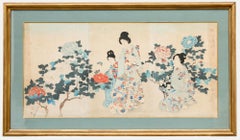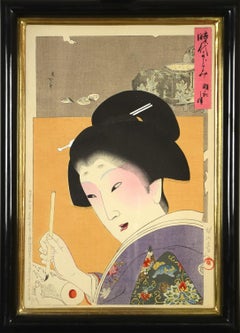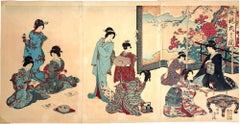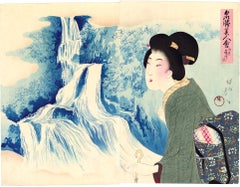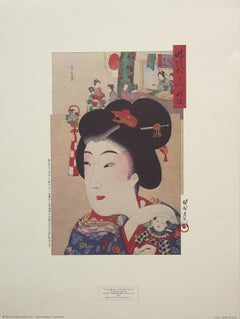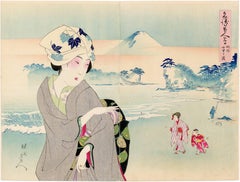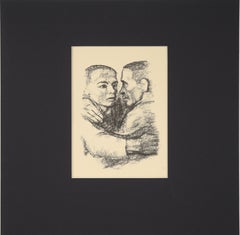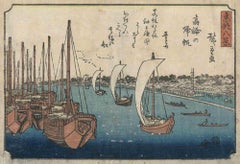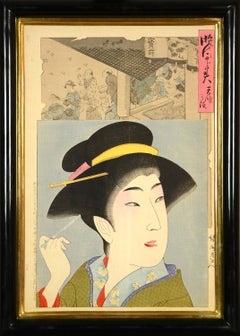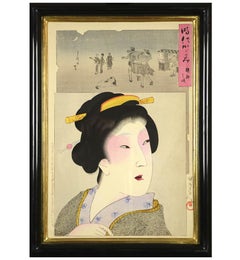CHIKANOBU, Yoshu Art
to
1
1
3
1
1
Overall Width
to
Overall Height
to
5
1
4
2
6
5
4
4
3
2
1
1
1
1
1
1
1
4
3
3
2
1
6
10,043
2,758
1,381
1,375
3
4
2
Artist: CHIKANOBU, Yoshu
Yoshu Chikanobu (1838-1912) - Japanese Woodblock, Amongst the Flowers Triptych
By Yoshu Chikanobu
Located in Corsham, GB
A delightful triptych by the Japanese ukiyo-e artist Yoshu Chikanobu (1838-1912). The three sections combine to make a single image of women in richly decorated kimonos surrounded by...
Category
19th Century CHIKANOBU, Yoshu Art
Materials
Woodcut
A Set of Six Bust Portraits of Beauties - Jidai Kagami (Mirror of the Ages).
By Yoshu Chikanobu
Located in London, GB
CHIKANOBU, Yoshu (1838–1912)
A Set of Six Bust Portraits of Beauties - Jidai Kagami (Mirror of the Ages).
1896-1898
A Set of Six oban tate-e woodblock prints of okubi-e (bust portraits) of beauties, titled Jidai kagami (Mirror of the Ages), documenting the fashions of former times (from the Keicho to the Meiji era) in chronological order, each sheet with a beautiful woman in sumptuous costume depicted at the lower section and a rectangular panel at the top which makes a reference to the era, some sheets with lacquer and embossed details, published by Matsuki Heikichi, variously dated Meiji 29, 30 and 31 (1896-8), all signed Yoshu Chikanobu. Each sheet approx. 36 x 23.7 cm (14 1/8 x 9 3/8 in).
oyohara Chikanobu (1838–1912), better known to his contemporaries as Yōshū Chikanobu, was one of the most successful woodblock print artists of Japan's Meiji period. He lived at a time when Japan saw the reinstatement of the emperor as ruler and underwent rapid westernization. He worked both with traditional subjects, such as actors, courtesans, scenes of famous sites, beautiful women, and with topical subjects, such as the Satsuma Rebellion (1877) and the Sino-Japanese War (1894-1895). Chikanobu used the flat planes and decorative patterning of the ukiyo-e tradition to striking effect, adding brilliant colors, especially reds, purples, and blues to his compositions.
More precisely, Ukiyo-e, or ukiyo-ye (in Japanese: "pictures of the floating world"), is a genre of woodblock prints and paintings that flourished in Japan from the 17th through 19th centuries. It was aimed at the prosperous merchant class in the urbanizing Edo period (1603–1867). Amongst the popular themes were depictions of beautiful women, as is the case here with these okubi-e prints (i.e. bust portraits); kabuki actors and sumo wrestlers; scenes from history and folk tales; travel scenes and landscapes; flora and fauna; and erotica.
One of Chikanobu’s best series, A Mirror of the Ages shows women by fashion and hair style throughout history. Despite a sense of longing for the past, these prints are unmistakably modern and of their time. Each print depicts a beauty from a certain period in the lower part and customs at that time, in grisaille, in the upper part - a way to tell viewers about the latest fashion and historical backgroud at that time. The quality of printing is outstanding, especially in Chikanobu’s use of white for the rendering of the powdered faces. Indeed, Chikanobu was known as a master of bijinga (images of beautiful women), and for illustrating changes in women's fashion, including both traditional and Western clothing...
Category
1890s Other Art Style CHIKANOBU, Yoshu Art
Materials
Wood
(Untitled), from the series Pictures of ladies' etiquette
By Yoshu Chikanobu
Located in Middletown, NY
Tokyo: c1893.
Wooblock tryptich printed in colors on hand laid mulberry paper, 14 3/4 x 29 inches (375 x 737 mm), the full sheet. Meiji period. In very good condition with extensive...
Category
Late 19th Century CHIKANOBU, Yoshu Art
Materials
Handmade Paper, Woodcut
Japanese Beauty Admiring Kirifuri Waterfall
By Yoshu Chikanobu
Located in Burbank, CA
A beauty turns to admire the Kirifuri Waterfall in Nikko Province. She holds the handle of an umbrella and wears fashionable clothing that is beautifully printed. This series pairs f...
Category
1890s Edo CHIKANOBU, Yoshu Art
Materials
Handmade Paper, Mulberry Paper, Woodcut
$940 Sale Price
20% Off
"Young Woman of the Meiji" by Yoshu Chikanobu, Lithographic Print.
By Yoshu Chikanobu
Located in Chesterfield, MI
Published by Portal Publications.
Printed in USA
Good Condition
24 x 18
Category
20th Century CHIKANOBU, Yoshu Art
Materials
Lithograph
Beauties on the Beach with view of Mount Fuji
By Yoshu Chikanobu
Located in Burbank, CA
Shichirigahama, Sagami Province. A beauty in the foreground waves to her young companions, who run towards her on the beach. The beauty at left wears a western-style golden ring. We ...
Category
1890s Edo CHIKANOBU, Yoshu Art
Materials
Handmade Paper, Mulberry Paper, Woodcut
Related Items
"Brotherhood" lithograph by Käthe Kollwitz
By Käthe Kollwitz
Located in Soquel, CA
Bold print of "Brotherhood" by Kathe Kollwitz (German, 1867-1945). This piece is one of the Lithographic reproductions of the original lithographs, plate 3 from a series of 10, print...
Category
1940s Expressionist CHIKANOBU, Yoshu Art
Materials
Paper, Ink, Lithograph
Takanawa no Kihan - Woodblock print by Utagawa Hiroshige - 1843-1847
By Utagawa Hiroshige
Located in Roma, IT
Takanawa no kihan is a modern artwork realized between 1843 and 1847 after Utagawa Hiroshige.
Ukiyo-e color woodblock print from the Touto hakkei (The Eight Famous Views of the Capital of the East) series.
Mounted under passepartout.
The artwork depicts the port of Takanawa, a suburb of Minato in southern Tokyo, and is one of the very rare sheets by Utagawa Ando Hiroshige...
Category
Mid-19th Century Modern CHIKANOBU, Yoshu Art
Materials
Woodcut
$779
H 6.93 in W 9.61 in D 0.04 in
"Enshoku Sanju-roku Kasen" (Thirty-six Enchanting Flowers) Woodblock on paper
By Toyohara Kunichika
Located in Soquel, CA
"Enshoku Sanju-roku Kasen" (Thirty-six Enchanting Flowers) Woodblock on paper
Elegant woodblock print by Toyohara Kunuchika (Japanese, 1835-1900). Three women are in talking with each other inside, while a man waits outside holding a bag of some kind. The colors in this piece are rich and saturated, primarily blues, greens, and purple.
Mat size: 16"H x 20"W
Paper size: 14.75"H x 9.88"W
Born in 1835, Toyohara Kunichika grew up in the Kyobashi district of Edo in the midst of merchants and artisans. In 1848, at age 13, he was accepted as an apprentice into the studio of Utagawa Kunisada I...
Category
1880s Edo CHIKANOBU, Yoshu Art
Materials
Ink, Rice Paper, Woodcut
$380 Sale Price
20% Off
H 20 in W 16 in D 0.25 in
Painting in Gold Frame
By Roy Lichtenstein
Located in Aventura, FL
From the Paintings series. Woodcut, Lithograph, screen print and collage on Arches 88 paper. Hand signed, dated and numbered by Roy Lichtenst...
Category
1980s Pop Art CHIKANOBU, Yoshu Art
Materials
Lithograph, Screen, Woodcut, Paper
Kiyomi Barrier & Seiken Temple Near Okitsu- Japanese Woodcut Print on Rice Paper
By Utagawa Hiroshige
Located in Soquel, CA
Kiyomi Barrier & Seiken Temple Near Okitsu - Japanese Woodcut Print on Rice Paper
Woodblock print of boats in a harbor by Utagawa Hiroshige (Japanese, 1797-1858). Originally publish...
Category
1850s Impressionist CHIKANOBU, Yoshu Art
Materials
Rice Paper, Woodcut
$1,240 Sale Price
20% Off
H 15.5 in W 19.25 in D 1.25 in
Self Portrait, Expressionist Lithograph by Alberto Giacometti
By Alberto Giacometti
Located in Long Island City, NY
Alberto Giacometti, Swiss (1901 - 1966) - Self Portrait From Derriere Le Miroir no. 127, Year: 1961, Medium: Lithograph, Edition: ~2500, Size: 15 x 11 in. (38.1 x 27.94 cm), Publ...
Category
1960s Expressionist CHIKANOBU, Yoshu Art
Materials
Lithograph
Head, Expressionist Lithograph by Alberto Giacometti
By Alberto Giacometti
Located in Long Island City, NY
Alberto Giacometti, Swiss (1901 - 1966) - Head From Derriere Le Miroir no. 127, Year: 1961, Medium: Lithograph, Edition: ~2500, Size: 15 x 11 in. (38.1 x 27.94 cm), Publisher: M...
Category
1960s Expressionist CHIKANOBU, Yoshu Art
Materials
Lithograph
Matsubaya - Woodblock Print by Utagawa Kuniyoshi - Mid-19th Cent.
By Utagawa Kuniyoshi
Located in Roma, IT
Yosooi of the Matsubaya is an Original Woodcut Print, Oban Format, realized by Kitagawa Tsukimaro.
Good condition but many folds in the paper.
No signature.
Kitagawa Tsukimaro ( 1...
Category
Mid-19th Century Modern CHIKANOBU, Yoshu Art
Materials
Woodcut
$550
H 14.18 in W 9.65 in D 0.04 in
Edo Landscape Japanese Woodblock Print
By Utagawa Hiroshige (Ando Hiroshige)
Located in Houston, TX
Edo Meisho woodblock print of a famous Japanese coastal dock. This woodblock is most likely apart of the series "One Hundred Famous Views of Edo." The woodblock print is printed on r...
Category
1850s Edo CHIKANOBU, Yoshu Art
Materials
Woodcut
$1,500
H 10 in W 15 in D 0.004 in
One Hundred Aspects of the Moon, Mt Otawa Moon - Bright God Tamura
By Tsukioka Yoshitoshi
Located in Soquel, CA
"Mount Otawa Moon: Bright God Tamura" - Woodblock on Paper by Tsukioka Yoshitoshi
From the series "One Hundred Aspects of the Moon"
This piece depicts the general Sakanoe no Tamura...
Category
1880s Edo CHIKANOBU, Yoshu Art
Materials
Paper, Ink, Woodcut
$750
H 20.5 in W 15.5 in D 0.75 in
Shunga - Woodcut by Katsukawa Schuncho - Mid-18th Century
By Katsukawa Shunshō
Located in Roma, IT
Shunga is an original modern artwork realized by Katsukawa Schuncho (1726 – 1793) in the half of the 18th Century.
Erotic scene from the series "Koshuko zue juni ko".
A courtesan with a customer under a kimono stand...
Category
Mid-18th Century Modern CHIKANOBU, Yoshu Art
Materials
Paper, Woodcut
$3,356
H 7.88 in W 11.82 in D 0.04 in
19th century color woodcut Japanese ukiyo-e print female geisha figure signed
By Utagawa Kuniyoshi
Located in Milwaukee, WI
This print is from a highly regarded series by the Edo woodblock artist Utagawa Kuniyoshi: in the period, there were at times prohibitions in depicting a...
Category
1850s Edo CHIKANOBU, Yoshu Art
Materials
Paper, Pigment, Woodcut
Utagawa Kuniyoshi19th century color woodcut Japanese ukiyo-e print female geisha figure signed, 1852
$8,410
H 21.5 in W 17.5 in
Previously Available Items
A Group of Six Bust Portraits of Beauties - Jidai Kagami (Mirror of the Ages).
By Yoshu Chikanobu
Located in London, GB
CHIKANOBU, Yoshu (1838–1912).
A Group of Six Bust Portraits of Beauties - Jidai Kagami (Mirror of the Ages).
1896-1898
A Group of Six oban tate-e woodblock prints of okubi-e (bust portraits) of beauties, titled Jidai kagami (Mirror of the Ages), documenting the fashions of former times (from the Keicho to the Meiji era) in chronological order, each sheet with a beautiful woman in sumptuous costume depicted at the lower section and a rectangular panel at the top which makes a reference to the era, some sheets with lacquer and embossed details, published by Matsuki Heikichi, variously dated Meiji 29, 30 and 31 (1896-8), all signed Yoshu Chikanobu. Each sheet approx. 36 x 23.7 cm (14 1/8 x 9 3/8 in).
Toyohara Chikanobu (1838–1912), better known to his contemporaries as Yōshū Chikanobu, was one of the most successful woodblock print artists of Japan's Meiji period. He lived at a time when Japan saw the reinstatement of the emperor as ruler and underwent rapid westernization. He worked both with traditional subjects, such as actors, courtesans, scenes of famous sites, beautiful women, and with topical subjects, such as the Satsuma Rebellion (1877) and the Sino-Japanese War (1894-1895). Chikanobu used the flat planes and decorative patterning of the ukiyo-e tradition to striking effect, adding brilliant colors, especially reds, purples, and blues to his compositions.
More precisely, Ukiyo-e, or ukiyo-ye (in Japanese: "pictures of the floating world"), is a genre of woodblock prints and paintings that flourished in Japan from the 17th through 19th centuries. It was aimed at the prosperous merchant class in the urbanizing Edo period (1603–1867). Amongst the popular themes were depictions of beautiful women, as is the case here with these okubi-e prints (i.e. bust portraits); kabuki actors and sumo wrestlers; scenes from history and folk tales; travel scenes and landscapes; flora and fauna; and erotica.
One of Chikanobu’s best series, A Mirror of the Ages shows women by fashion and hair style throughout history. Despite a sense of longing for the past, these prints are unmistakably modern and of their time. Each print depicts a beauty from a certain period in the lower part and customs at that time, in grisaille, in the upper part - a way to tell viewers about the latest fashion and historical backgroud at that time. The quality of printing is outstanding, especially in Chikanobu’s use of white for the rendering of the powdered faces. Indeed, Chikanobu was known as a master of bijinga (images of beautiful women), and for illustrating changes in women's fashion, including both traditional and Western clothing...
Category
1890s Other Art Style CHIKANOBU, Yoshu Art
Materials
Wood
H 15.75 in W 11.34 in D 1.19 in
Yoshu Chikanobu, Four Bust Portraits of Beauties, woodblock prints, signed, 1896
By Yoshu Chikanobu
Located in London, GB
A Set of four oban tate-e woodblock prints of okubi-e (bust portraits) of beauties, titled Jidai kagami (Mirror of the Ages), documenting the fashions of former times (from the Keicho to the Meiji era) in chronological order, each sheet with a beautiful woman in sumptuous costume depicted at the lower section and a rectangular panel at the top which makes a reference to the era, some sheets with lacquer and embossed details, published by Matsuki Heikichi, variously dated Meiji 29, 30 and 31 (1896-8), all signed Yoshu Chikanobu. Each sheet approx. 36 x 23.7 cm (14 1/8 x 9 3/8 in), framed and glazed.
Toyohara Chikanobu (1838–1912), better known to his contemporaries as Yōshū Chikanobu, was one of the most successful woodblock print artists of Japan's Meiji period. He lived at a time when Japan saw the reinstatement of the emperor as ruler and underwent rapid westernization. He worked both with traditional subjects, such as actors, courtesans, scenes of famous sites, beautiful women, and with topical subjects, such as the Satsuma Rebellion (1877) and the Sino-Japanese War (1894-1895). Chikanobu used the flat planes and decorative patterning of the ukiyo-e tradition to striking effect, adding brilliant colours, especially reds, purples, and blues to his compositions.
More precisely, Ukiyo-e, or ukiyo-ye (in Japanese: "pictures of the floating world"), is a genre of woodblock prints and paintings that flourished in Japan from the 17th through 19th centuries. It was aimed at the prosperous merchant class in the urbanizing Edo period (1603–1867). Amongst the popular themes were depictions of beautiful women, as is the case here with these okubi-e prints (i.e. bust portraits); kabuki actors and sumo wrestlers; scenes from history and folk tales; travel scenes and landscapes; flora and fauna; and erotica.
One of Chikanobu’s best series, A Mirror of the Ages shows women by fashion and hair style throughout history. Despite a sense of longing for the past, these prints are unmistakably modern and of their time. Each print depicts a beauty from a certain period in the lower part and customs at that time, in grisaille, in the upper part - a way to tell viewers about the latest fashion and historical backgroud at that time. The quality of printing is outstanding, especially in Chikanobu’s use of white for the rendering of the powdered faces. Indeed, Chikanobu was known as a master of bijinga (images of beautiful women), and for illustrating changes in women's fashion, including both traditional and Western clothing...
Category
1890s CHIKANOBU, Yoshu Art
Immortal Goddess on Beach
By Yoshu Chikanobu
Located in Burbank, CA
Original Japanese woodblock print diptych of an immortal Goddess wreathed in clouds looking protectively down on a beach. In excellent, mint condition (note that the colors on the tw...
Category
1890s Other Art Style CHIKANOBU, Yoshu Art
Materials
Mulberry Paper, Color
A Pair of Bust Portraits of Beauties - Jidai Kagami (Mirror of the Ages).
By Yoshu Chikanobu
Located in London, GB
A Pair of oban tate-e woodblock prints of okubi-e (bust portraits) of beauties, titled Jidai kagami (Mirror of the Ages), documenting the fashions of for...
Category
1890s CHIKANOBU, Yoshu Art
Chikanobu, Yoshu art for sale on 1stDibs.
Find a wide variety of authentic CHIKANOBU, Yoshu art available for sale on 1stDibs. You can also browse by medium to find art by CHIKANOBU, Yoshu in handmade paper, mulberry paper, paper and more. Not every interior allows for large CHIKANOBU, Yoshu art, so small editions measuring 12 inches across are available. Customers who are interested in this artist might also find the work of Utagawa Yoshitora, Kunichika Toyohara, and Toyohara Kunichika. CHIKANOBU, Yoshu art prices can differ depending upon medium, time period and other attributes. On 1stDibs, the price for these items starts at $150 and tops out at $6,813, while the average work can sell for $963.
